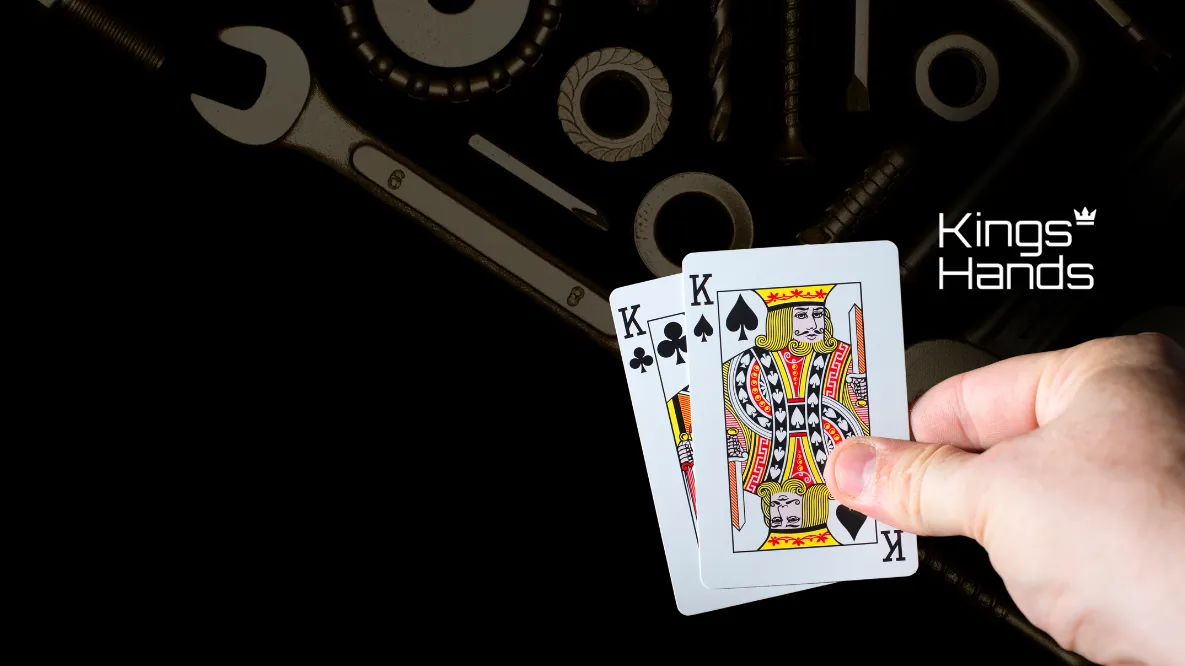Pot odds are one of the most basic forms of poker math, but they’re also one of the most important as they help you determine whether or not it’s profitable to call a bet from your opponent. This is done by looking at how much you need to call to win the pot and the amount of equity you’d need to have to be profitable.
While it may sound a little complicated, pot odds are easy to work out, and we’ll be guiding you every step of the way. So, keep reading to find out what pot odds are and how to calculate them at the table.
What Are Pot Odds?
Pot odds are a mathematical concept that represents the ratio between the size of the bet you’re facing and the size of the pot. For example, if there is $20 in the pot, and your opponent bets $10, you have to call $10 to win a pot of $30 (the initial $20 pot plus your opponent’s $10 bet). In this example, you have to pay ⅓ of the pot to have a chance of winning the whole pot, which is expressed as pot odds of 3:1.
We use pot odds to help us determine whether or not a call is profitable. Once we have worked out the pot odds we’re being laid, we can convert that number into a percentage. This percentage tells us the minimum amount of equity we’re required to have to profitably call the bet.
This calculation is why pot odds are so important in poker and are a foundation of any winning player’s strategy; in order to be a winning player, you need to understand which decisions are profitable and which are unprofitable.
How To Calculate Pot Odds
So, how do we go about calculating pot odds and the amount of equity required to make a profitable call? Well, there’s a step-by-step process that we’ll lay out for you here – while there are multiple steps to the calculation, they’re all easy to do and can be easily done at the table with enough practice.
Let’s take a look at an example to get us started.
We’re on the river, and we’re facing a bet from our opponent. They’ve bet $200 into a $200 pot, and we want to work out our pot odds along with the equity required to profitably call this bet.
To do this, we start by working out the odds we’re being laid by our opponent. This can be expressed with the following formula:
Pot Odds = Total Pot Size : Bet Size
We have to call $200 into a $400 pot (remember, always add your opponent’s bet to the pot when making these calculations). So, plugging in our numbers, we get the following:
Pot Odds = $400 : $200
These numbers can be simplified down to 2:1, meaning that we’re getting pot odds of 2:1 on this call. From here, we can work out our minimum equity requirements by performing another calculation:
Minimum Equity = (Size of call / (Size of pot + Size of call)) * 100
That might look scary, but it’s actually much easier than it looks. Let’s plug the numbers in from our example and see how it works.
Minimum Equity = ($200 / ($400 + $200)) * 100
Minimum Equity = ($200 / $600) * 100
Minimum Equity = 0.33 * 100 = 33%
After completing the calculation, you can see that you need a minimum of 33% equity to make a profitable call in this scenario.
How To Calculate Pot Odds More Easily
If you’re dealing with large numbers, it can be hard to quickly perform the calculations that give you the minimum equity requirement to continue in the hand. However, there’s an easy way to make these calculations using the pot odds ratio that we worked out at the beginning of the process.
In our above example, rather than dividing $200 by $400+$200, we can instead use the 2:1 pot odds number and perform the same calculation. This is because the numbers are ratios of one another, so whether you use the small numbers or the big numbers, you’ll arrive at the same answer. I’m sure you’ll agree that dividing 1 by 2+1 is much easier to do on the fly than dividing 200 by 400 + 200, so I’d recommend using the smaller numbers when making your calculations at the table.
Pot Odds In Action
Now that we understand the theoretical side of pot odds, let’s take a look at how they’re used in-game. In this example, we’re looking at a hand from High Stakes Poker Season 9. Garrett Adelstein faces off against John Robert Bellande in a huge hand, where JRB is put to a tough decision.
We’re on the river with JRB, who has QJ on a board of Jc7c9dQs3h – a very strong hand. However, Garrett has just made a huge bet – betting $125,000 into a pot of $85,000. Given the size of the bet, QJ isn’t looking as strong as it once was, but JRB is going to run the math to see how much equity he needs against Garrett’s range to profitably continue.
To do this, he’s first going to work out the pot odds. With a bet of $125,000 into a pot of $85,000, he needs to call $125,000 to win $210,000, giving him odds of roughly 17:10, or 1,7:1. With this information, JRB can then run a quick calculation to see what his minimum equity requirement is to profitably call.
Minimum Equity = (1 / 2.7) * 100
Minimum Equity = 0.37 * 100 = 37%
After running the calculations in his head, JRB found that he needed at least 37% equity against Garrett’s betting range to profitably continue. Ultimately, he made the call and ran into the nuts of Garrett Adelstein. However, by running the calculation, he was able to determine whether or not his call would be profitable against Garrett’s range, meaning that even though he lost this time, it could still be a winning call in the long run.
Pot Odds Test
So, we’ve broken down exactly what you need to do to calculate pot odds and work out the minimum equity required to make a profitable call – but how well have you remembered it? Let’s put your newfound knowledge to the test with a series of questions designed to test your knowledge on the subject. The more you practice, the better you’ll become, and the quicker you’ll be able to perform these calculations at the table.
Question 1
Your opponent has bet $100 into a $300 pot. What are the pot odds you’re getting in this situation? Express your answer as a ratio (i.e. 100:1)
Question 2
Your opponent has bet $500 into a $1250 pot. What is the minimum amount of equity required to profitably continue against this bet?
Question 3
Your opponent has bet $880 into a pot of $1000. What are the pot odds you’re getting in this situation and what is the minimum amount of equity required to profitably continue against this bet?
Summary
Pot odds are an essential part of poker math as they’re a key component in the most basic profitability calculations. Without an understanding of pot odds, you can only guess whether a call with your hand will be profitable or not.
By calculating your pot odds, you can determine the price you’re getting laid by your opponent and the minimum amount of equity you require to profitably continue with your hand. This allows you to make a decision that’s rooted in sound mathematical principles rather than guessing at what the best decision would be.
Stay tuned for our next article on poker math, where we’ll be combining pot odds and poker probabilities to calculate the profitability of a call, by following us on Facebook and Instagram.
Answers:
Question 1 – Your pot odds in this situation are 4:1.
Question 2 – The minimum amount of equity required to continue profitably in this hand is 22%.
Question 3 – Your pot odds in this situation are 2.1:1 and the minimum amount of equity required to continue profitably in this hand is 32%.





















